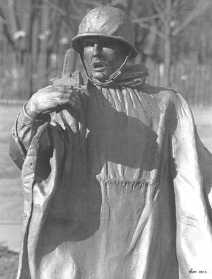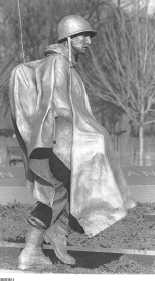jets flew from carriers for the first time in a war
situation. Unlike World War II, the enemy didn’t have
the capability to strike our carriers, so pilots launched
their Corsairs and Banshees on the first sustained
ground-support missions in history.
The helicopter also came of age during the Korean
Conflict. First studied and developed in 1942 when the
Navy received four Sikorskys, the choppers were
spotters for artillery. In Korea, they flew emergency
supply runs and took part in direct combat duties. Later,
the helicopter was used as a cargo transport between
ships during underway replenishment, search and
rescue missions, and ASW exercises. Korea was the
testing ground for the helicopter and many other
innovations our forces currently use.
On September 15, 1950, under massive shore
bombardment by U.S. Navy ships, the amphibious
landings at Inchon began. The successful operation cut
enemy communications, split enemy forces, and
dissolved enemy resistance in that area. The shelling of
supply roads far inland by the battleship USS Missouri
demonstrated a new tactical concept. That concept was
the Navy’s ability to intervene successfully in a ground
operation far ashore.
The Korean Conflict (fig. 5-13 and fig. 5-14) lasted
until July 1953. Other events were happening in the Navy
while the war was being waged. For example, a program
was established giving outstanding enlisted women the
opportunity to receive commissions in the Regular Navy.
KOREA TO VIETNAM
The 1950s was a time of change. By the end of the
decade, most operational aircraft in the attack and
fighter arsenals of the sea service were jets. More and
more angled-deck carriers were authorized, and new
deck-edge elevators allowed simultaneous takeoffs and
landings.
The USS Nautilus, the first nuclear submarine, was
first put to sea on January 17, 1955. Under Commander
Eugene P. Wilkinson, the USS Nautilus transmitted the
historic signal, “Underway on nuclear power.” On its
shakedown cruise in May 1955, the USS Nautilus
steamed submerged from New London, Connecticut, to
San Juan, Puerto Rico. It traveled over 1,300 miles in 84
hours—a distance 10 times greater than the record for
continuously submerged travel by any previous
submarine.
After more than 2 years of operation and evaluation,
the USS Nautilus was refueled in April 1957. On its first
nuclear core, it steamed a total of 62,562 miles; it made
more than half of that cruise while totally submerged. A
conventionally powered submarine the size of the USS
Nautilus would have required over 2 million gallons of
fuel oil to duplicate that feat. A train of tank cars over a
mile and a half long would have been necessary to
transport that amount of fuel.
5-21
Student Notes:
Photograph courtesy of Mr. Francis Jeffery.
Figure 5-13.—Korean War Memorial.
Photograph courtesy of Mr. Francis Jeffery.
Figure 5-14.—Korean War Memorial—soldier.




